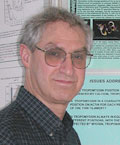William Lehman, Ph.D.

Professor of Physiology and Biophysics
Direct Contact: wlehman@bu.edu
Publications Positions and Honors
We are involved in structural studies on the assembly and function of actin-containing thin filaments in striated and smooth muscles as well as on those present in non-muscle cells. Our principal goals are (1) to analyze and elucidate the mechanisms of thin filament-linked regulation of muscle contraction and (2) to determine the role of tropomyosin as the thin filament gatekeeper controlling access of additional actin-binding proteins onto actin filaments, thus controlling cytoskeletal architecture. To accomplish these goals, we use a combination of molecular biology, electron microscopy, electron tomography, and image reconstruction to better understand the structural interactions and dynamics of protein components of isolated and reconstituted thin filaments. More recently, we have initiated a new approach to characterize thin filament components using state-of-the-art computer simulation techniques involving Molecular Dynamics (MD) protocols. To date, our analysis of the electron microscopy of thin filament proteins and the results of the in silico Molecular Dynamics have in all cases been mutually supportive. In a number of instances, the MD simulations have yielded insights not easily obtained experimentally. We combine our studies on native thin filament components with corresponding ones on mutants to better understand abnormal filament function in disease processes.
Our laboratory confirmed the steric-blocking mechanism of muscle regulation by identifying the positions assumed by tropomyosin on actin in the presence and the absence of Ca2+using cryo-electron microscopy and negative staining. We also have demonstrated that on activation tropomyosin moves away from myosin cross-bridge binding sites on actin in two steps, one induced by Ca2+ binding to troponin and a second induced by the binding of myosin to actin. We demonstrated that the shape of tropomyosin is designed to match the contours of the F-actin filament and that tropomyosin’s curved shape is semi-rigid, and thus capable of cooperative movement on thin filaments. Merging our experimental results and our computational chemistry, we developed the first all atoms model of the F-actin-tropomyosin filament.
Our laboratory is continuing the above-mentioned studies to obtain even greater resolution of the processes involved in regulating contractile and cytoskeletal filaments in striated and in smooth muscle filaments. At the same time, we are investigating the structural organization of troponin on thin filaments and the changes it undergoes on binding of Ca2+. We are also engaged in studies on the structural interactions of other actin binding proteins including α-actinin, caldesmon, calponin, cortactin, and native and mutant dystrophin, filamin, fimbrin, fascin, leiomodin and tropomodulin, namely proteins that play important roles in the organization of the cytoskeleton in striated and smooth muscles as well as in non-muscle cells.
The scientific contributions that we have made have had profound implications on current Biomedical and Translational research. For example, assays that we developed led to the discovery of myosin-phosphorylation as a regulator of smooth muscle contractility. Drugs to modulate the cascades associated with this process are much in demand and in development. We also now examine how the smooth muscle cell cytoskeleton is modulated to control vascular smooth muscle stiffness, which is a major contributor and leading risk factor in the development of cardiovascular dysfunction. Moreover, we have for the first time indicated at an atomic level how point mutations in tropomyosin associated with Hypertrophic Cardiomyopathies can lead to muscle dysfunction.